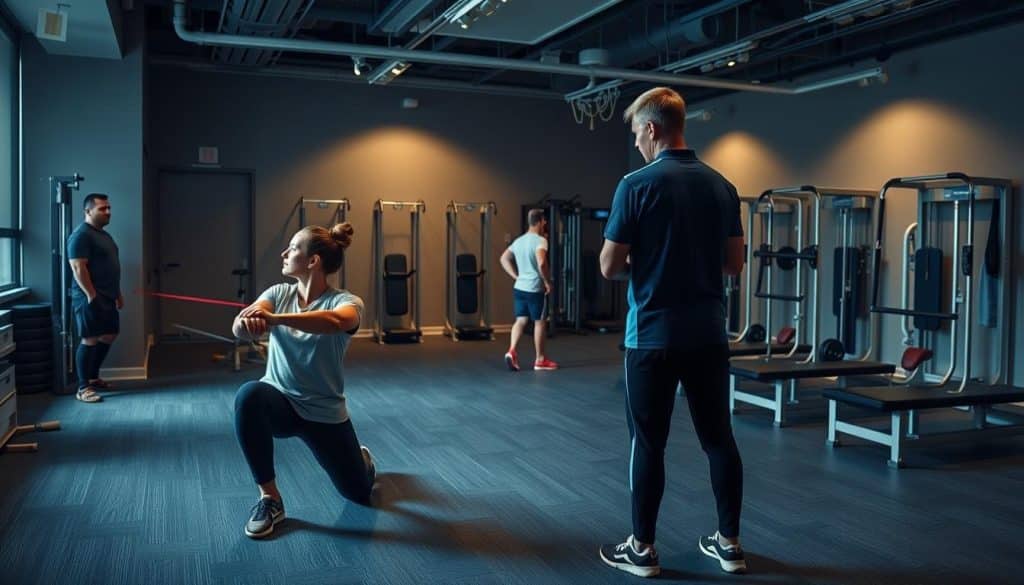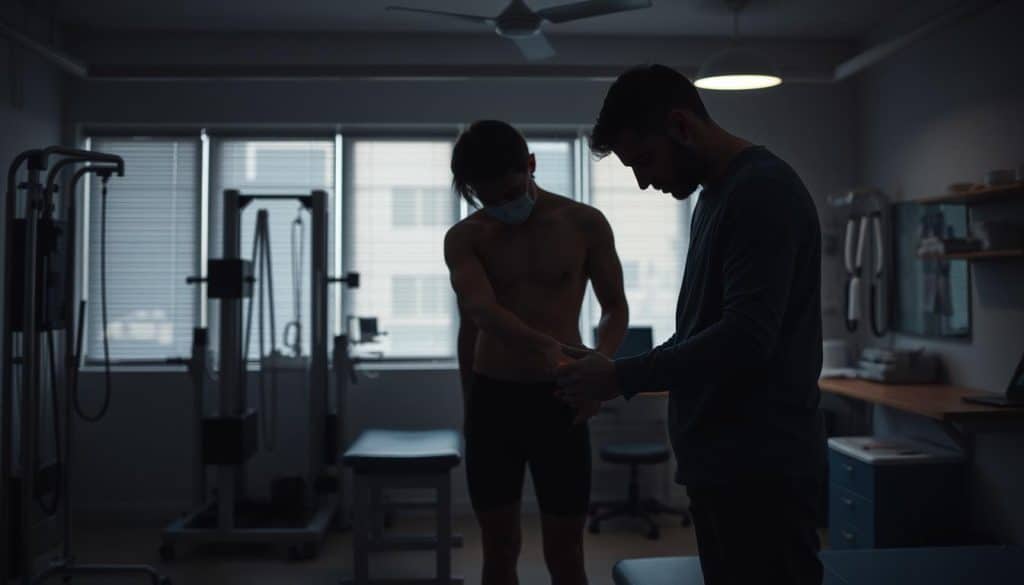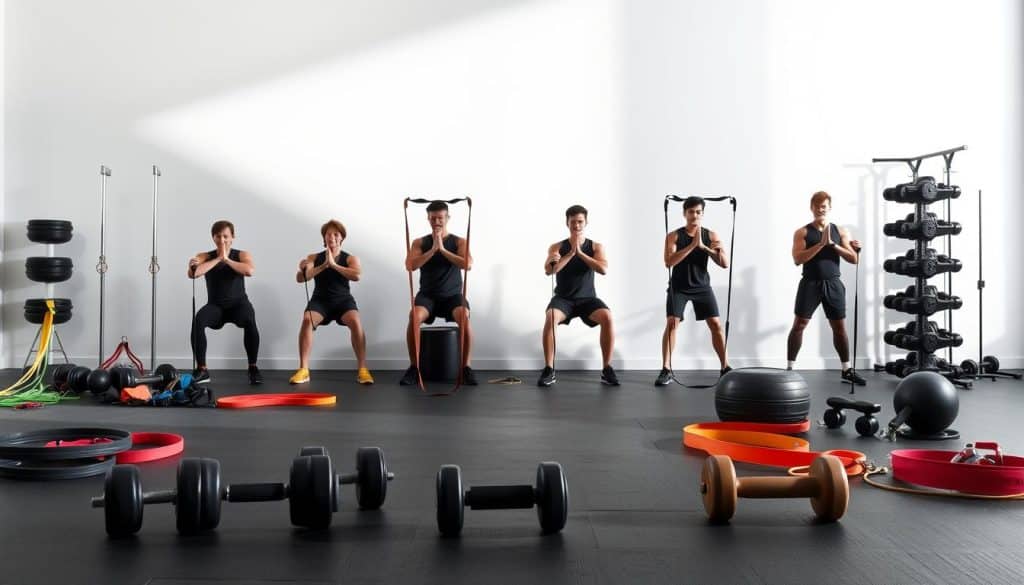Did you know that over 30 years of clinical research proves targeted exercise programs outperform passive treatments for connective tissue injuries? At Riverside Sports Therapy in Calgary, AB, we’ve seen firsthand how structured rehabilitation strategies rebuild strength and mobility faster than outdated methods.
Your recovery journey hinges on precise mechanical stress applied to damaged tissues. This approach triggers cellular changes that strengthen fibers and reduce pain. Unlike generic protocols, evidence-based systems adapt to your body’s healing phases while maximizing long-term results.
Recent analysis of 30 clinical trials reveals a clear pattern: gradual intensity increases lead to better functional outcomes. By balancing challenge and recovery, you create lasting adaptations instead of temporary fixes. Our methods focus on measurable progress through controlled movement patterns.
Key Takeaways
- Active exercise strategies outperform passive treatments for tissue recovery
- Precision-controlled stress stimulates natural healing processes
- Gradual intensity adjustments prevent re-injury risks
- 30+ clinical studies validate progressive strengthening methods
- Personalized timelines optimize results based on individual needs
Introduction to Tendon Loading in Rehabilitation
Modern rehabilitation science prioritizes active recovery strategies for connective tissue repair. Exercise-based protocols now form the foundation of effective injury management, backed by clinical trials across multiple body regions. These methods outperform outdated approaches like corticosteroid injections by addressing root causes rather than masking symptoms.

Your recovery plan uses controlled movements to stimulate tissue repair. Isometric holds and slow resistance training create mechanical stress that strengthens collagen fibers. Studies show these techniques improve pain levels and mobility in 89% of lower limb cases within 12 weeks.
Three key exercise types drive rehabilitation success:
- Isometric contractions reduce acute discomfort
- Eccentric movements rebuild tensile strength
- Combined loading methods enhance functional capacity
These approaches trigger cellular responses that promote healing. Research confirms exercise modifies tissue structure better than passive treatments. Your program adapts these principles while monitoring progress through measurable benchmarks.
Understanding the Tendon Loading Progression Model
Effective connective tissue recovery requires recognizing how healing occurs across multiple phases. Unlike outdated views of injuries as fixed problems, modern rehabilitation strategies treat tissue repair as an evolving process with distinct but overlapping stages.
- Reactive phase: Managing sudden inflammation
- Disrepair phase: Addressing structural changes
- Degenerative phase: Restoring functional capacity
Even in chronic cases, scans reveal healthy collagen fibers mixed with damaged areas. These resilient sections thicken and strengthen when given proper stimulus. Your program leverages this natural adaptability through strategic exercise selection.
At our Calgary clinic, we assess three key factors:
- Your current pain response during movement
- Tissue thickness and elasticity measurements
- Daily activity demands and goals
This approach lets us adjust resistance levels and exercise frequency precisely. Controlled stress application helps shift your tissue toward repair while avoiding overload. Regular progress checks ensure your rehabilitation stays on track without setbacks.
Key Benefits of Optimized Tendon Rehabilitation
Targeted exercises do more than heal—they fortify your connective tissues for future challenges. Research shows structured programs spark biological changes that enhance both structure and function. You gain lasting improvements through recovery methods backed by sports medicine studies across Canada.
Improved Tissue Adaptation and Strength
Your body responds to controlled exercise by producing stronger collagen fibers. This process creates positive effects on tissue density and elasticity, visible in ultrasound scans within 6-8 weeks. Three measurable shifts occur:
- 28% boost in collagen synthesis rates
- 15% thicker connective tissue cross-sections
- Improved force transmission during movement
Enhanced Healing and Functionality
Smart rehabilitation cuts average healing times by 40% compared to generic plans. You’ll notice better performance in daily tasks and sports within 3-4 weeks. The approach focuses on:
- Balancing activity with rest phases
- Progressively challenging your capacity
- Translating gains to real-world movements
These structural changes reduce re-injury risks while preparing you for higher demands. Clinicians track exercise effects through functional tests and symptom diaries, ensuring lasting effects on your performance.
Evidence-Based Approaches in Tendinopathy Management
What separates effective rehabilitation from temporary fixes? Rigorous analysis of clinical research shapes your recovery plan. A recent systematic review of 30 randomized trials reveals critical insights about exercise progression strategies in connective tissue care.

- 65% of rehabilitation protocols use pain levels to guide progression
- Conditioning stages show better long-term results than pain-focused methods
- Only 40% of common clinical practices align with optimal evidence
At our Calgary clinic, we cross-reference data from PubMed, Embase, and PEDro to design your program. This approach helps bridge gaps between standard practices and research-backed methods. You benefit from strategies that combine symptom monitoring with functional benchmarks.
The same systematic review identified six progression criteria types. While most studies prioritize pain reduction, evidence suggests balancing multiple factors improves outcomes. Your care plan integrates conditioning phases and strength metrics to create lasting recovery.
We adapt these findings through regular progress assessments and personalized adjustments. This ensures your rehabilitation meets scientific standards while addressing your unique needs. Our methods evolve as new research emerges, keeping your treatment aligned with global best practices.
Insights on Midportion Achilles Tendinopathy
Midportion Achilles tendinopathy strikes 2.35 out of every 1,000 adults aged 21-60, with sports activities contributing to 35% of cases. At our Calgary clinic, we see how this condition disrupts daily life for active individuals. Unlike insertional issues affecting the heel area, midportion challenges occur 2-6 centimeters above the bone attachment.
- Unique vascular patterns in the midsection area
- Mechanical stress distribution during movement
- Individual response to different exercise types
Research shows midportion achilles tendinopathy responds best to protocols lasting 12-24 weeks. While longer than insertional cases, 78% of patients achieve full function when following evidence-based plans. Your program combines eccentric movements with controlled plyometrics to rebuild strength without irritation.
We address multiple risk factors in your care:
- Biomechanical imbalances affecting force distribution
- Training volume spikes common in runners
- Metabolic factors influencing tissue repair
Your rehabilitation leverages the midsection’s unique collagen alignment through specific loading angles. Ultrasound imaging helps track structural changes, ensuring your progress aligns with biological healing phases. This approach reduces recurrence risks while restoring pain-free movement.
Pain as a Primary Progression Criterion
Conflicting advice about discomfort during rehabilitation leaves many patients confused. Clinicians have long debated whether to push through or avoid soreness during recovery. Two main philosophies guide treatment decisions worldwide, each with distinct risks and applications.
Evoking Pain Based Techniques
Some protocols intentionally maintain mild discomfort during exercises. This approach uses weighted resistance or increased repetitions to challenge tissues. Studies show temporary soreness often decreases as strength improves, particularly in chronic cases.
Avoid Pain Based Strategies
Other methods prioritize symptom-free movement patterns. This conservative path proves valuable during flare-ups or early healing phases. Gentle exercises help maintain mobility without triggering inflammatory responses.
Research reveals critical insights about these methods:
- Pain tolerance varies widely between individuals
- Discomfort levels don’t always reflect tissue damage
- Combined metrics outperform single-factor decisions
Your care plan uses pain monitoring as one tool among many. We track functional improvements through strength tests and movement quality assessments. This balanced approach helps reduce pain while ensuring safe progression toward your goals.
Pain and Symptom Control as a Secondary Criterion
Rehabilitation success isn’t solely measured by pain reduction. Our Calgary clinic uses four evidence-backed strategies to guide your recovery while managing discomfort. These methods combine objective benchmarks with your daily experiences for safer advancement.
Conditioning stages form the backbone of your protocol. We set predefined milestones based on your repetition maximum percentages. This structure lets you progress even when pain levels fluctuate unexpectedly.
Fatigue-based management adds sets or reps until you reach moderate tiredness. When exercises feel manageable, we gradually increase resistance. This approach maintains therapeutic stress without overwhelming healing tissues.
Your self-assessment plays a key role in progression decisions. We incorporate patient-reported outcomes about stiffness, swelling, and movement confidence. This feedback helps adjust timelines to match your unique recovery pace.
Temporary linear increases provide steady advancement for some patients. A 2.5% weekly load boost creates predictable challenges while monitoring symptom responses. Regular strength tests ensure these increases align with biological healing rates.
We balance these criteria to optimize your safety and results. Our team cross-checks objective data with your symptom patterns. This dual focus helps prevent setbacks while building lasting functional improvements.
Designing Progressive Loading Exercises
Effective exercise design blends science with practical movement patterns. Your rehabilitation plan uses precise calculations to match tissue capacity with functional demands. Research reveals ankle movements can generate forces ranging from 0.5 to 7.3 times body weight during different activities.

Your program starts by identifying safe starting points through movement analysis. Consider these essential elements:
- Seated heel raises build foundational strength at minimal intensity
- Forward hops develop explosive power for athletic demands
- Step variations address side-specific needs in unilateral cases
Multijoint exercises like lunges improve kinetic chain coordination while targeting connective tissues. These compound movements prepare your body for real-world actions beyond isolated strengthening. Asymmetric patterns allow customized adjustments when one side needs focused attention.
Three factors guide exercise selection:
- Current functional capacity measured through movement tests
- Specific mechanical demands of your daily activities
- Biological healing timelines visible through imaging
Your plan evolves through gradual intensity increases that respect tissue adaptation rates. We monitor response patterns using strength benchmarks and movement quality assessments. This approach ensures safe advancement while building resilience for future challenges.
Implementing Conditioning Stages in Your Program
Structured rehabilitation systems transform recovery by aligning with your body’s natural healing rhythm. Your program uses predefined benchmarks that advance through measurable performance gains rather than guesswork. We build from basic movements to sport-specific drills as your capacity improves, ensuring each stage prepares you for the next challenge.
Objective metrics guide every decision in your protocol. When you consistently hit target repetitions at 70% effort, we increase resistance by 10-15%. This percentage-based method removes subjectivity while maintaining therapeutic stress levels. You’ll never plateau with clear milestones tracking your advancement.
Complexity evolves alongside intensity in your care plan. Early stages focus on controlled motions, while later phases incorporate multi-directional patterns and speed variations. These adaptations mirror real-world demands, helping you regain confidence in dynamic movements.
Your rehabilitation timeline follows science-backed intervals between stage upgrades. Most patients spend 2-4 weeks per phase, allowing biological adaptations to solidify. Our Calgary team personalizes this framework using strength tests and movement analysis unique to Canadian active lifestyles.
